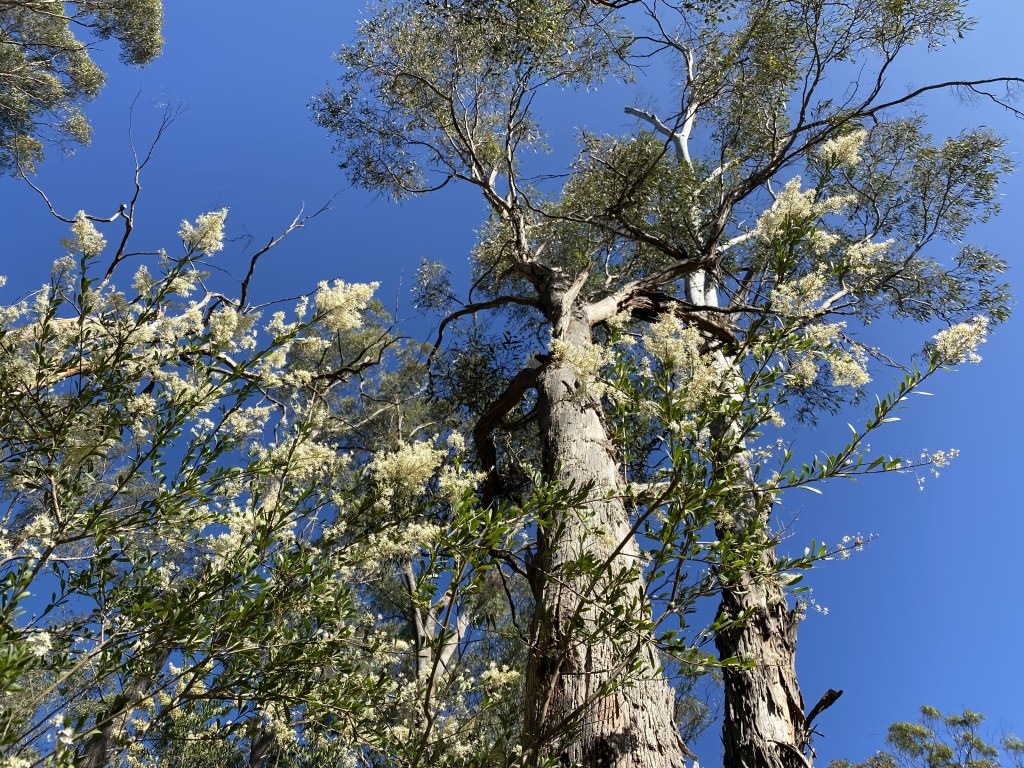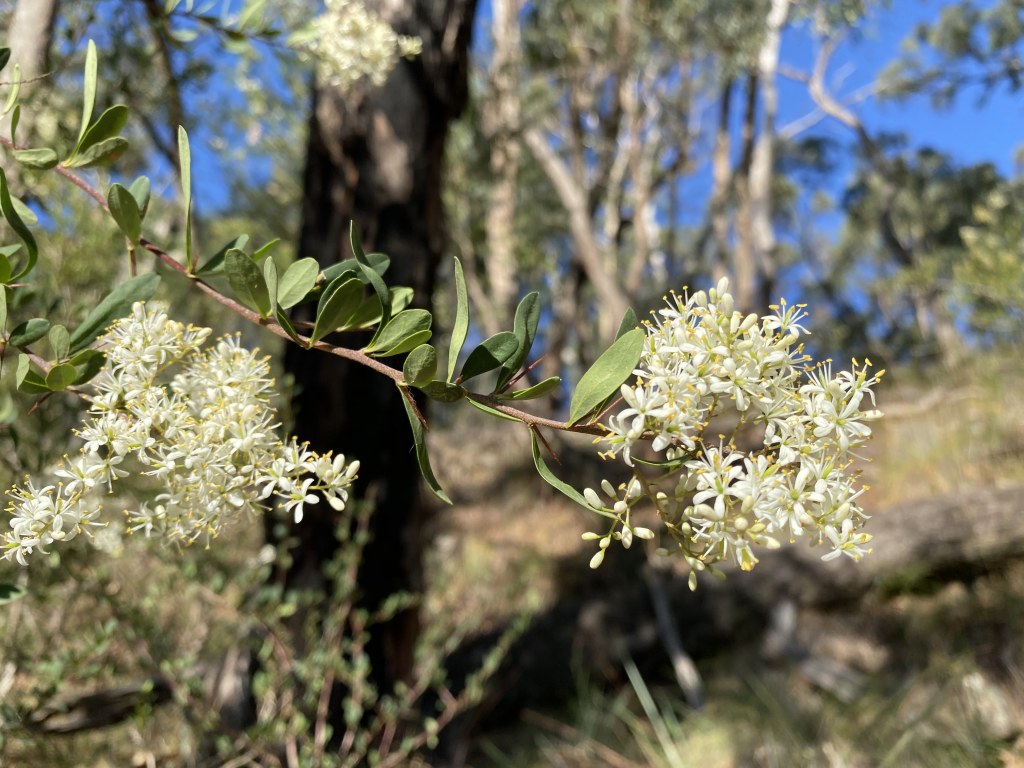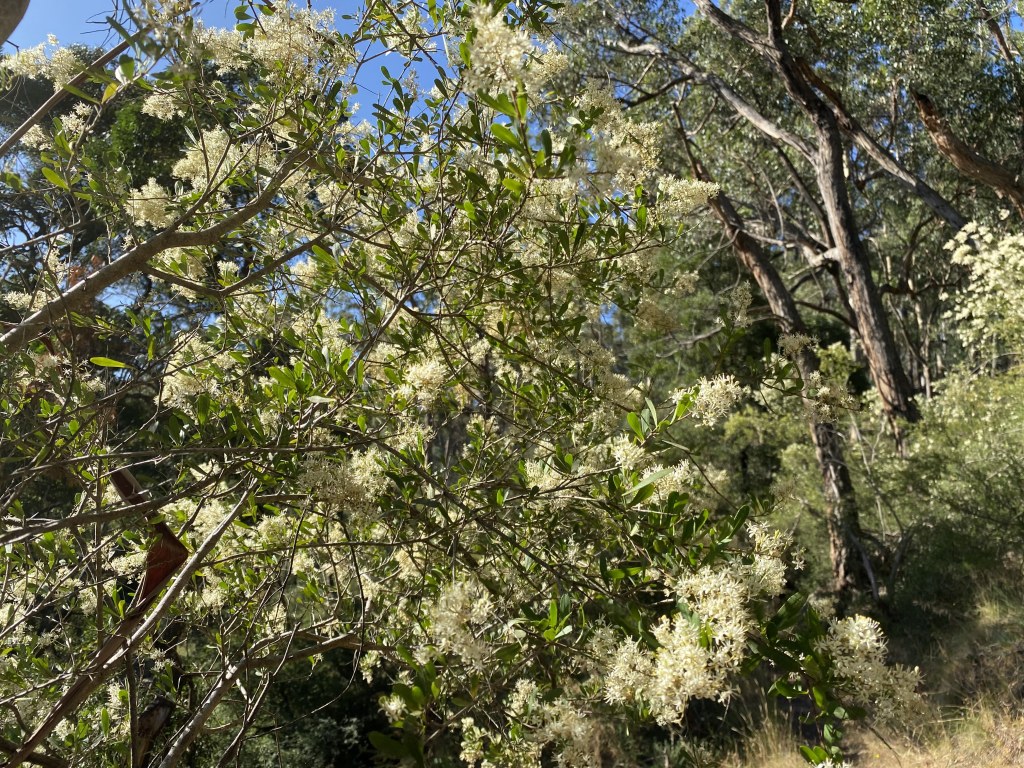This summer has seen a spectacular flowering of Sweet Bursaria.
In mid-January I visited Tipperary Springs and the creekline vegetation was all aglow with creamy white flowers. The air smelt sweet and hummed with the buzzing of flies and bees.
Sweet Bursaria is very widespread species – growing in all States except WA and NT, and its form varies from shrub to tree, depending on the soil and rainfall of its habitat.
In the Wombat Forest, Sweet Bursaria is tree-like with a rough trunk. They are surprisingly long-lived at 25 – 60 years. Some of the oldest specimens I have seen are at Tipperary, but who knows – these hardy survivors can resprout from their trunk after a bushfire has gone through, so some of the plants which look just like a small shrub could be actually decades old!

Sweet Bursaria is a simply wonderful habitat plant, playing a multitude of roles in forest and woodland ecology.
The flowers are tiny white flowers, growing in large bunches at the tip of the branches of the plant – providing easy access to a wide array of pollinators. European Honeybees seem to relish the pollen, but there are a host of other native insects that love their Sweet Bursaria.
Beetles such as jewel beetles, tumbling flower beetles, longicorn beetles and scarab beetles have been recorded with the most pollen – and therefore the most useful pollinators. The appropriately named flower wasps are also good pollinators.
At present many of the flowers have been pollinated and the characteristic seed pods are forming – these will be bright green at first, then turn to brown as the seed ripen. The seed then feeds birds such as Bronzewing Pigeons.
Some larvae of jewel beetles tunnel in the dead branches, feeding on the wood. Caterpillars of several moth species feed on the leaves, and one moth caterpillar specialises on the abundant lichen that grows on the Bursaria trunks.

Sweet Bursaria also has a very close relationship with a few species of copper butterflies (Paralucia), most famously, the somewhat misnamed Eltham Copper Butterfly – the largest remaining populations of which are in Castlemaine, in Kalimna Park!
There are also copper butterflies in the Wombat Forest, probably the Bright Copper.
The butterflies have a very close relationship with small black ants. The adult butterflies lay their eggs on the Sweet Bursaria. While the caterpillars feed on the leaves, the ants tend to the caterpillars, protecting them from predators such as birds and wasps, and in turn the ants feed on sugary exudate from the caterpillars’ rear ends.
The caterpillars even spend the night in special chambers in the ant nests at the base of the shrub, and when the time comes, this is where they pupate, in a lovely safe, climate-controlled environment.
Due to its prickly nature, the Sweet Bursaria is also a great nesting site for small birds. I have seen the delicate and mossy cup nest of the Yellow-faced Honeyeater woven among the spiny branches.
Landcare websites, wildlife friendly gardening and farming books all rave about the virtues of this wonderful plant – a must for any revegetation project!

Thanks Tanya,
Lovely reading,very I formative and hope the I sects,bees,honeyeater all multiply and keep the pollination going strong.
Thanks Vanessa! Me, too : )
We fenced off a few sweet bursarias on our block at Clunes because they were being nibbled down to bare branches by the kangaroos. It’s made a big difference, they’ve got lots of new leaves now, so I hope they’ll recover enough to flower again one day!
Oh I am sure! The shrubs seem to like a bit of browsing – as long as they have a chance to recover eh!
Great post Tanya. I too love Sweet Bursaria and have it planted as screening, windbreaks, shelter for other plants, and particularly as I read somewhere that it attracted a native wasp which predated on cockchafer/curly grubs which were prolific in our 6 acres. Can’t prove anything but there are few grubs now!